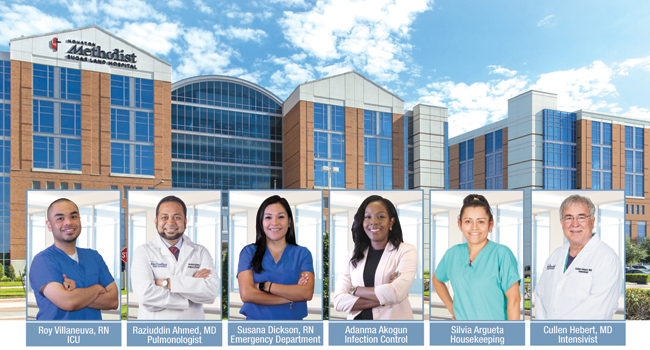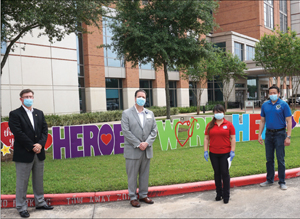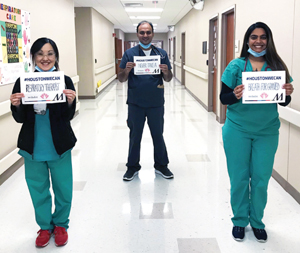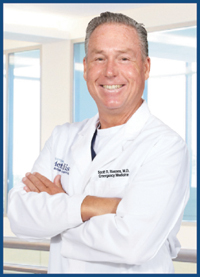Posted on Jun 28, 2020 in
COVER STORY

FOCUS | Cover Story –
Chris Siebenaler won’t forget the moment that COVID-19 became a reality in Fort Bend County.
It was the first week of March, and the Houston Methodist Sugar Land Hospital regional senior vice president and CEO received a text on his phone alerting him that Fort Bend officials would be hosting a news conference the next morning to discuss the county’s first coronavirus patient.
“We had been preparing for that moment for several months, but nobody knew exactly when our community would be impacted,” Siebenaler recalled. “Even though the first patient wasn’t being treated at Houston Methodist Sugar Land, that text was still a wake-up call – COVID-19 was here in Fort Bend, and it was just a matter of time before we would be called into action.”
It didn’t take long. The day after the news conference, patients with suspected coronavirus symptoms began showing up at Houston Methodist Sugar Land. At first, a slow trickle; and later, in steady numbers, day after day.
“We were as prepared as we could be, but given how little we knew about the virus itself, it became very challenging, very quickly,” Siebenaler said. “That first week, I remember feeling a sense of uncertainty despite all of our planning – there were just so many unknowns. But I was confident that our team would respond with skill, compassion and commitment. And they did.”
The story of the hospital’s fight with COVID-19 is one of preparation, resiliency and the spirit of teamwork, underpinned by Houston Methodist’s core values. Faced with perhaps the most important medical challenge of their careers, the physicians and staff at Houston Methodist Sugar Land rose to the occasion to serve the people of Fort Bend and surrounding areas.
First Reports Spark Preparation
The hospital’s intense focus on planning began in December 2019, when Janan Sackllah, MPH, CIC, senior infection preventionist, first received initial reports out of China of a novel, highly infectious coronavirus.
“We stay on top of these alerts because we serve an international community, and it’s always possible that we will see cases of emerging diseases sooner rather than later,” said Sackllah. “We began planning for our first patients within days of receiving the reports.
“It was clear to us that this was a highly contagious disease and that we would need to use the utmost care in dealing with patients. From that point on, our focus in Infection Control was on ensuring that we had the proper personal protective equipment (PPE) on hand and that our staff was properly trained in its use.”
Next Step: Logistical Problem-Solving
The hospital soon implemented daily planning meetings with a core group of leaders representing key departments. That team worked diligently to prepare the hospital for the expected surge, organizing everything from patient care protocols to procurement of supplies and physical modifications of the hospital’s infrastructure.
“What stands out to me is how committed everyone was to doing whatever it took to meet this challenge head-on and succeed,” said Eliud Faz, chief operating officer. “Watching our people come together and problem-solve so many complex issues – on the fly – was remarkable.”
In February, hospital staff began a series of drills to work through the processes needed to safely identify and separate suspected coronavirus patients when they arrived, examine them in the Emergency Department and move them to a designated unit in the hospital if they needed care.
“We eventually did a physical walk-through, with a team of 15 people from all impacted departments, to test how everything would work and make sure it could be done safely,” said Kelly Ward, director of the Emergency Department.
By the time patients began showing up in March, the hospital had a detailed plan in place that would keep suspected COVID-19 patients isolated from the moment they arrived. Throughout the next few weeks, representatives from Infection Control were on hand to observe and assist front-line staff at every step of the process to ensure safety protocols were followed.
Preparing the Facility

Sino Professionals Association and the Chinese American Community donated 30,000 surgical masks and 1,000 medical isolation gowns.
Another critical element in the hospital’s response was building out a designated COVID-19 unit that could keep a large number of patients isolated. The team selected the hospital’s Brazos Pavilion, which already housed an intensive care unit (ICU) and three medical/surgical units.
That rapid reconfiguration effort was the responsibility of the hospital’s facilities team, which oversaw the conversion of 58 new negative pressure rooms across three units and the two intensive care units. The purpose of negative pressure rooms is to prevent air from circulating from a COVID-19 room to the rest of the hospital.
“What made this so challenging was the scale and speed we needed to convert the rooms,” said Paul Forbes, facilities manager. “We typically only set up negative pressure for one space at a time – usually to prevent dust from spreading during construction or renovation. Converting an entire unit over a weekend is a whole new ballgame, but we did it.”
Hospital leadership was also charged with developing a plan for securing the hospital campus to limit the number of visitors and ensure that everyone entering the building – staff included – was properly screened for symptoms.
Ground Zero: The Emergency Department
On June 17th, when the hospital was at its busiest, Houston Methodist Sugar Land treated 49 hospitalized positive COVID-19 patients at one time. So far, we have been fortunate not to see the hundreds of cases similar to New York and other hot spots around the world.
“We saw a steady stream of patients with every shift,” said Scott Rivenes, M.D., Emergency Department medical director. “Patients with a cough and fever and many with shortness of breath. As the health care community began to learn more about this disease, we added additional symptoms to the list of screening criteria. It was an ever-changing situation.”
The hospital’s plan called for initial patient screening in the vestibule of the ER. Those with possible COVID-19 symptoms were routed through a separate entrance and assigned to designated exam rooms to ensure they were kept apart physically from other patients.
“The dual screening process prevented patients who were presenting with other issues from coming in contact with suspected COVID-19 patients,” said Rivenes. “That approach served us well.”
At one point, a tent was installed outside the ER so that staff could examine those who were less ill and provide rapid assistance without the need for the patient to enter the hospital.
Caring and Compassion on the Front Lines

Respiratory Care Team.
Once patients moved from the Emergency Department into the COVID-19 units in the Brazos Pavilion, responsibility for their care shifted to a team of Houston Methodist Sugar Land physicians, nurses and other professionals who worked seamlessly – and tirelessly – to serve.
“In the beginning, there was a lot of uncertainty among our staff,” said Janet Leatherwood, chief nursing officer. “This was something new and relatively unknown. But our staff responded with such tenacity and were all in this together, as a team, taking care of our community.”
One of the biggest challenges facing front-line staff was that patients weren’t allowed visitors, to prevent spread of the coronavirus.
“Normally, patients are surrounded by their loved ones, supporting them during their hospitalization,” said Leatherwood. “But even our non-COVID-19 patients were not allowed visitors, which was something that we never experienced before. This definitely affected our patients’ morale as well as the staff.”
In response, the staff went above and beyond to provide comfort. “Our caregivers really became an extension of each patient’s family,” said Sally Shen, associate chief nursing officer. “They went out of their way to connect emotionally with our patients who were alone and afraid. And they did whatever they could to communicate frequently with family members who couldn’t be there. We saw a lot of creativity from our staff to help patients and their families feel connected.”
Those caregivers on the front line – and the professionals supporting them behind the scenes – demonstrated unique skill in problem-solving. For example, to preserve PPE, ventilator monitors were moved to the anterooms so that staff could adjust the equipment without entering the patient’s room.
“Those out-of-the-box ideas – and there were many of them – made a tremendous difference in our response,” said Faz. “The creativity of our people was amazing, and so was the willingness of our support functions to do whatever was needed as quickly as possible.” Physicians were creative, too, finding ways to deliver timely care despite the expanded safety precautions.
“Our physicians were quick to adapt,” said Cullen Hebert, M.D., lead intensivist in the ICU. “They made all the necessary adjustments – utilizing PPE effectively, conducting rounds in a safe manner and implementing telemedicine where appropriate. It was a lot of change in a short timeframe, but they did whatever they could to help.”
Sometimes, that meant going beyond bedside care. “We had a patient who was upset because he was going to be admitted and there was no one at home to feed his pets,” said Siebenaler. “Dr. Raziuddin Ahmed told him, ‘Don’t worry … give me your keys and I’ll stop by your house and feed them.’ That’s a perfect example of the compassion our physicians and staff demonstrated daily.”
Community Support Kept Spirits High
Through it all, the physicians and staff at Houston Methodist Sugar Land were uplifted by the support of the community.
“So many people have reached out,” said Siebenaler. “From donating food and PPE to churches having concerts in the parking lot, the response has been overwhelming. Every day, we had people from the community showing their support in some way.”
“Balloons, signs, posters, Girl Scout cookies, thank-you notes, lunch and dinner – the support we received meant so much to everyone,” said Leatherwood. “It was very rewarding to see that the community recognized what we were doing and wanted to help in whatever way they could.”
Perhaps one of the most memorable moments was the flyover of the U.S. Navy’s Blue Angels, who soared over the hospital on May 6th in a tribute to healthcare providers. “That was amazing,” said Siebenaler. “Everyone was just in awe, sharing that sense of pride and commitment.”
As the numbers began to slow, and hospital staff could take the time to reflect on the initial response, one difference-maker stood out. “The key was teamwork,” said Siebenaler. “We could not have responded as effectively as we did without everyone coming together. There was not a department or function in the hospital that was unaffected by this, and there were just as many champions behind the scenes as there were on the front lines – housekeeping, facilities, information technology, food and nutrition, communications, supply chain and many more.”
The hospital also benefited from daily collaboration and communication with other institutions across the Houston Methodist system. The sharing of information, ideas and best practices strengthened and supported Houston Methodist Sugar Land’s response.
“All of Fort Bend can be proud of the team here at Houston Methodist Sugar Land,” said Siebenaler. “Our people came together selflessly and gave their best. Just as important, the lessons we learned will serve us well as we continue to care for patients with COVID-19. We’re confident that we are properly prepared, even in the event of another surge, and that we can continue to serve the community safely.”
Don’t Delay Care – The Hospital Is Safe!

Scott Rivenes, M.D., Medical Director, Emergency Department.
It’s one of the most common questions people have about health care now: Is the hospital safe?
“I get asked that daily,” says Scott Rivenes, M.D., medical director of the Emergency Department. “The answer is ‘absolutely!’ No one should be concerned about coming to the hospital or seeing their physician. We’ve got detailed, thorough protocols in place to protect patients and ensure that they are safe from exposure to all types of illnesses, including COVID-19.”
In addition to constant deep cleaning and the use of CDC-approved disinfectants – including UV lighting sanitizers – Houston Methodist Sugar Land has instituted several new processes to keep patients safe:
- Mandatory masking and social-distancing guidelines for all
physicians, employees and patients.
- Patient screening to identify possible symptoms or exposure risk.
- Staggered in-person appointments to reduce patient contact.
- Expanded virtual services.
- Daily screening and frequent testing of employees as
recommended by the CDC.
- Mandatory personal protective equipment rules for all staff
and physicians.
- A new in-car check-in process as well as reconfigured waiting
rooms and check-in lines to support social distancing.
“The safety of our patients has always been a priority,” said Chris Siebenaler, regional senior vice president and CEO. “Don’t ignore your health or put off needed services. We are here for you.”

To learn more about Houston Methodist Sugar Land Hospital, visit houstonmethodist.org/sugarland or our Facebook page at fb.com/methodistsugarland for the latest news, events and information.



 <
<









